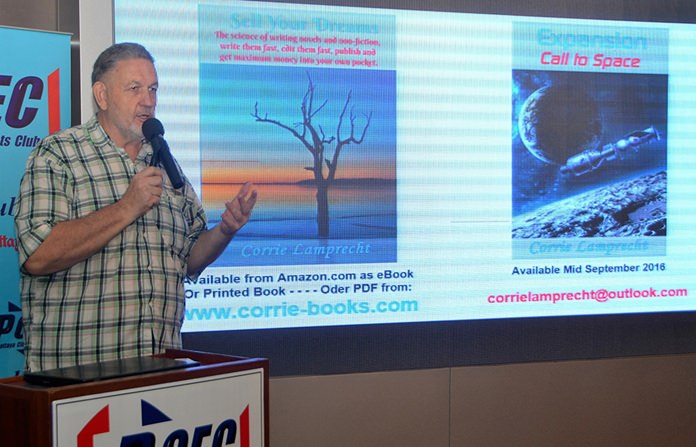Sell your dreams was the theme at the September 4 meeting of the Pattaya City Expats Club. Using the anatomy of the human body as a reference outline for writing a book, author and researcher Corrie Lamprecht gave an intriguing presentation about “the Anatomy of Writing.” Corrie said he recently developed this method after many years of writing, both successfully and unsuccessfully.

In Corrie’s anatomy metaphor of writing, the brain is the reader. So the first question a writer must ask is, “Who is my reader?” Whatever your subject might be, you must decide who you want to read your book.

The body is the book. But before getting to the body, there is a little organ called the Medulla Oblongata, located in the brain stem, which connects the brain and the body. Every nerve, everything that happens in your body, has to pass through the Medulla Oblongata. Any injury to the Medulla Oblongata is usually fatal. So, too, if the connection between your book and reader fails, the result is fatal. In Corrie’s metaphor, the Medulla Oblongata is a book’s “Premise Line.” The premise line consists of one or two sentences that defines, describes and sells your book to the reader. The Premise Line should be no more than 150 words. Just as the Medulla Oblongata filters everything that goes from the body to the brain, everything in the book must be filtered by the premise line.

Corrie gave an example of a Premise Line: “After . . . a group of scientists set out on a private mission to take revenge on one of their own. Using their combined knowledge of metallurgy and bio-engineering, they created the ultimate weapon of selective death.”
The next step is to create a skeleton, or outline, of the story. Corry said there are always three parts in any article or story: the introduction, the main body, and the conclusion. He gave several examples of possible outlines. He said the following basic outline is followed by 90 percent of American movies: “Trigger event, Set the stage, Problem, Turning point, Partial recover from problem, reawaken the problem with complications, Higher stakes, Major setback, Resolve the problem, Resolution.” His comment: “Boring!”
Corrie said different authors use various techniques to build an outline. Some use little post-it notes with various aspects of the plot, and move the notes around on a board until they get the desired outline. He showed a slide of J K. Rawlings’ outline for her first Harry Potter book: a hand-drawn spreadsheet with hand-written notes. Another technique is a worksheet based on Blake Snyder’s “beat sheet,” which tells what must happen at each minute.
Corrie’s anatomy technique uses the spinal cord, with its five sections and 33 vertebrae, as the core of his outline. The spinal cord, he said, controls the body and its movements. Each of the five sections has a main purpose, and from each vertebra are nerves and controls to specific organs, glands, muscles, and other body parts.
According to Corrie, preparing the outline represents about 30 percent of writing a book. Then comes the story and the development of the characters. He said the mistake most aspiring authors make is thinking that the story line is most important element; in reality the characters are most important. The characters will make or break your book. “A bad story with good characters is a Good Book. A good story with bad characters is a Bad Book,” he said. “If you have a perfect Character Outline, the story will write itself.”
Corrie said you will usually need at least four main characters. “Don’t make every person a superhero, and don’t make villain the devil,” he cautioned. Nobody is perfect. Each character must be human: they must have good or strong traits as well as bad or weak traits. To develop his characters, Corrie makes a personality profile using a well-known character as a similar personality – for example Kiefer Sutherland in “24” – combined with a photo of what he wants to convey to his reader – in this example, an archaeologist who grew up in the Australian Outback. He also uses the Chinese Zodiac to help develop the character’s personality traits. Then the next step is to imagine how each character will react to the events in your story.
Corrie also uses photographs in his outline to help him with setting for the scenes. He said it’s also important to include all six senses.
So now you’re finally ready to start writing – but wait! Why write? Why not let the computer do it for you? Corrie said that recently, with the help of a friend in Chiang Mai, he discovered voice recognition software, which allows you to speak into a microphone and let the computer write your words. He tried Dragon NaturallySpeaking, but prefers Google’s speech recognition software. He says that previously he had spent 600 hours taking courses on the Internet about writing, but still often experienced writers’ block. But since he started talking instead of writing, he rarely has that problem. Another advantage is that he can be sitting in a public place, talking into his smart phone, describing people and scenes that he sees around him, and the people have no idea he’s talking about them; they just think he’s talking to someone on the phone!
For more information about Corrie and his series of on-line books Sell your Dreams – what you need to know about writing books and publishing them online – visit his website: http://www.corrie-books.com/.
After the presentation, MC Roy Albiston brought everyone up to date on upcoming events and conducted the Open Forum, where questions are asked and answered about Expat living in Thailand, especially Pattaya. For more information on the PCEC’s many activities, visit their website at www.pcecclub.org.




